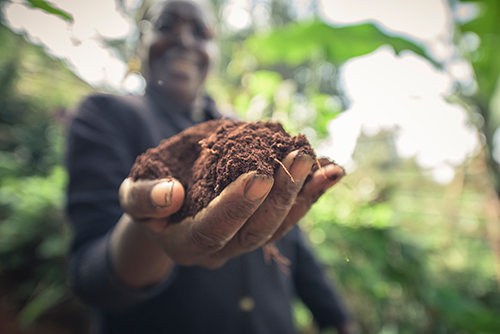Teams Like This
Soil organic matter is central to soil health in agriculture because it influences several important outcomes related to human and environmental well-being, like crop yield, carbon storage, and nutrient retention. There is momentum to build up soil organic matter for other working lands, like rangelands, where the benefits are less quantified. There is generally little quantitative evidence for which specific soil organic matter levels managers should target to achieve positive outcomes and avoid environmental consequences.
OUR APPROACH: This group aims to advance the science of soil organic matter to develop specific targets for management—and spatial prioritizing of management—to best meet agronomic outcomes and environmental benefits, for both row-crop and rangeland systems. This group focuses specifically on two case studies: rangelands in California and row-crop agriculture in the US midwest.

Relationship Between Soil Carbon, Crop Productivity, and Resilience to Drought
With a focus on row crops in the US Midwest and grazing lands in California, the team established that there is a solid relationship between soil carbon, crop productivity, and crop resilience to drought. Soil management has a large impact on a suite of environmental and agronomic outcomes due to these interconnected relationships.
Specific Recommendations
Soil management impacts the quality of soil for food production and environmental outcomes like water quality, biodiversity, and greenhouse gas emissions. It is crucial to develop evidence-based indicators for soil management to meet both agronomic and environmental goals. The team developed tools that refine our ability to make specific recommendations since general recommendations lack the specific targets necessary to prioritize where to build soil organic matter and how much.
AgEvidence database
This tool is a site that examines 224 studies conducted in the US Midwest over 47 years and assesses the benefits of common farming practices. It is both a motivational communications device to get partners excited about the impact of soil management, as well as a tool to quantify relationships between agricultural practices and agronomic performance indicators.

“We’ve generated new understanding that building soil carbon is important for agriculture to adapt to climate change. Our AgEvidence tool gives everyone, from farmers to CEOs, access to the science on conservation agriculture in the US Corn Belt.”
– Stephen Wood, Project Leader
This article details the AgEvidence tool, a multi-decade dataset which compiles the evidence base for Conservation Agriculture (CA), offering growers, researchers, policymakers, and other stakeholders the data necessary to assess the benefits and tradeoffs of enhancing crop yields while limiting environmental impact.
As part of a larger global effort to better understand the relationship between soil organic matter and crop yields, the team analyzed datasets from 29 countries.
This study argues that there is scientific consensus on the need to rebuild soil organic carbon for sustainable land stewardship. Knowledge in soil carbon restoration can benefit agriculture with well-informed policy and practice to protect and restore soils.
The Nature Conservancy
Soil Health Partnership
Point Blue
University of Florida
Yale University
The Nature Conservancy
Yale University
Stanford University
Yale University
Granular
The Nature Conservancy
Environmental Defense Fund
Cornell University
The Nature Conservancy
Woods Hole Research Center
The Nature Conservancy; Arizona State University
The Nature Conservancy
The Nature Conservancy
University of California, Davis
Yale University
The Nature Conservancy
The Nature Conservancy
Soil Health Partnership